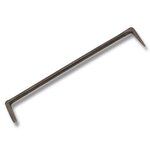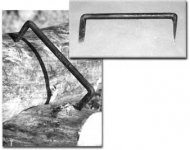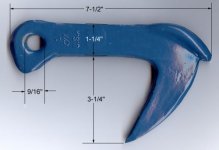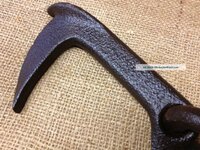macrota
Greenie
- Dec 9, 2012
- 19
- 2
- Detector(s) used
- White's Electronics
- Primary Interest:
- All Treasure Hunting
This iron object was found on private property in Montross, VA near Westmoreland State Park. The property has never been developed. It was dug 4-inches deep near a tree on a steep hill leading to shore of Lake Independence, a man-made reservoir.
The shape was obscured by thick rust blooms which were removed by electrolysis, then cleaned with a water and hydrochloric acid solution.
It's 4.5 inches long and seemingly forged for a special purpose. It is part of a larger object - broken off where indicated. The mushroomed curved top is symmetrically lapped under at the sides and the downward-curved terminate comes to a blunt point. The curved spike, wide at the base in profile view, terminates to a flattened end. The end of the spike is beveled like a chisel. It appears to be hand-forged and does not appear to be recently made. The mushroomed top does not appear to be hammered except at the time of forging.
What is it part of?


OBJECT IDENTIFIED!
GpSnoopy wins the satisfaction of solving this puzzle with a photo of a modern log grab. mical66 gets credit for noticing the top looked hammered and mushroomed, which I took issue with. In fact it was hammered and mushroomed like a spike - and apparently well-used.



This log grab was found on a steep hill where timber is, and probably was, abundant. It makes sense to employ one or more of these to yank a log from a steep hill using a horse or two on level ground. The blunt point on the end of the head might have kept the log grab from breaking free of the timber. The chisel-like tip of the spike would make is easier to hammer the device into wood. The mechanics of this object align with the utility of a log grab.
I'm satisfied that GpSnoopy and mical66 provided the solution and once again shown the power of forums.
The date of the object is undetermined.
Thanks,
macrota
http://marylandfreestateclub.com
The shape was obscured by thick rust blooms which were removed by electrolysis, then cleaned with a water and hydrochloric acid solution.
It's 4.5 inches long and seemingly forged for a special purpose. It is part of a larger object - broken off where indicated. The mushroomed curved top is symmetrically lapped under at the sides and the downward-curved terminate comes to a blunt point. The curved spike, wide at the base in profile view, terminates to a flattened end. The end of the spike is beveled like a chisel. It appears to be hand-forged and does not appear to be recently made. The mushroomed top does not appear to be hammered except at the time of forging.
What is it part of?


OBJECT IDENTIFIED!
GpSnoopy wins the satisfaction of solving this puzzle with a photo of a modern log grab. mical66 gets credit for noticing the top looked hammered and mushroomed, which I took issue with. In fact it was hammered and mushroomed like a spike - and apparently well-used.



This log grab was found on a steep hill where timber is, and probably was, abundant. It makes sense to employ one or more of these to yank a log from a steep hill using a horse or two on level ground. The blunt point on the end of the head might have kept the log grab from breaking free of the timber. The chisel-like tip of the spike would make is easier to hammer the device into wood. The mechanics of this object align with the utility of a log grab.
I'm satisfied that GpSnoopy and mical66 provided the solution and once again shown the power of forums.
The date of the object is undetermined.
Thanks,
macrota
http://marylandfreestateclub.com
Last edited:




















